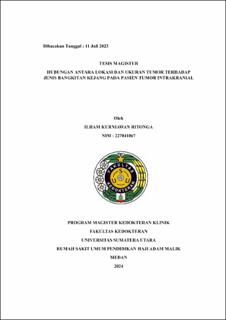| dc.description.abstract | Introduction: Brain tumors are rare with a worldwide incidence of 296,851 cases
worldwide. A large tumor size indicates a long duration of silent growth, allowing more
time for seizures to develop.
Aim: To determine the correlation between tumor location and size in patients with
intracranial tumors and the type of seizure.
Methods: This study used a cross-sectional design in patients who encountered seizure and
had been diagnosed with intracranial tumors undergoing treatment at H. Adam Malik
Hospital Medan We used Fisher Exact analysis test to determine the relationship of seizure
generation type in intracranial tumor patients based on tumor location and Chi-Square
analysis test to determine the relationship of seizure generation type in intracranial tumor
patients based on tumor size. This study included 43 patients with intracranial tumors
accompanied by seizures.
Results: The relationship between tumor location and the type of seizure generation shows
a variable proportion of data based on different locations. In the frontal lobe, focal and
generalized seizures occur with the same frequency (50% each). In the temporal lobe,
generalized seizures were more common (61.5%) compared with focal seizures (38.5%).
Likewise, in the parietal lobe, generalized seizures (68.4%) occurred more frequently than
focal seizures (31.6%). For the occipital lobe, all cases (100%) showed generalized
seizures, without focal seizures. Statistical analysis showed insignificant results between
tumor location and type of seizure with p value of 0.543 was obstained, indicating that
the relationship between tumor location and type of seizure was not significant (p < 0.05).
The results of the measurements showed that 2 patients with a size under 30 mm had focal
seizures (100%) while of the 41 patients with tumors measuring 30 mm or more, 13 patients
(31.7%) experienced focal seizures, while 28 patients (68.3%) experienced seizures.
general. The results of statistical analysis showed a significant result between tumor size
and type of seizure with p value of 0.048.
Discussion: There was no association between tumor location in intracranial tumor
patients and the type of seizure. However, there was a relationship between tumor size in
intracranial tumor patients and the type of seizure. | en_US |


